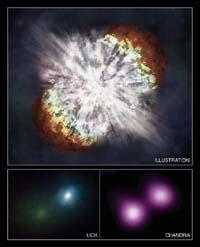The brightest supernova detected so far

NASA astronomers have detected the brightest supernova ever detected by the X-ray Chandra telescope and the terrestrial optical telescopes. The supernova, called sn2006gy, has been produced in a galaxy located 240 million light-years from Earth, the galaxy NGC 1260.
The explosion was observed in September 2006, but after analyzing the data, they now realize that sn2006gy is really special. In fact, although at first it was thought that the supernova was created by a small mass star, Chandra's data have found that the star was very large. It is calculated that its mass was 150 times greater than that of the Sun. So far, theories point to the fact that this star would generate a black hole in death. Not so, the supernova has released many subjects in space.
Astronomers believe that the first stars died like this, and so they were releasing the heavy elements that later formed part of the Sun and other stars.
On the other hand, the star Eta Carinae, located in the Milky Way at 7,500 light-years from the Earth, has eliminated a large mass before the explosion. Therefore, astronomers believe that it can also die in the form of a supernova.





